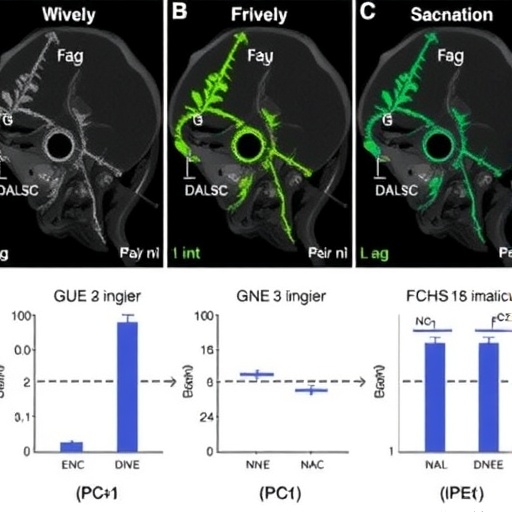In the relentless battle against head and neck squamous cell carcinoma (HNSCC), a malignancy notorious for its aggressive nature and dismal survival rates, researchers have unveiled a groundbreaking genetic signature that promises to revolutionize patient prognosis and therapeutic strategies. Utilizing cutting-edge CRISPR-Cas9 gene-editing technology, an international team of scientists has identified a set of proliferation-essential genes (PEGs) intricately linked to the clinical outcomes and immune environment of HNSCC, marking a significant leap in precision oncology.
Head and neck cancers, particularly HNSCC, have long posed a formidable challenge to oncologists due to their complex biology and limited treatment options. Traditional prognostic markers often fail to capture the heterogeneous nature of the disease, leading to suboptimal patient stratification and therapeutic decisions. The current study leverages functional genomic data derived from CRISPR-Cas9 screening—a technology that enables systematic gene knockouts—to ascertain which genes are indispensable for tumor cell proliferation, thus spotlighting vulnerabilities amenable to targeted interventions.
By mining data from the DepMap database, which aggregates CRISPR screening results across a vast array of cancer cell lines, researchers identified an extensive repertoire of 1,511 PEGs relevant to HNSCC. This expansive gene pool served as the foundation for developing a refined prognostic signature. Employing a rigorous statistical modeling approach that integrated univariate Cox regression, LASSO Cox regression, and multivariate Cox analyses, the investigators distilled this list into seven pivotal genes: MRPL33, NAT10, PSMC1, PSMD11, RPN2, TAF7, and ZNF335.
The strength of this seven-gene signature lies not only in its statistical robustness but also in its biological relevance, offering unprecedented accuracy in predicting patient survival outcomes. Validation across both internal and external patient cohorts confirmed the model’s capacity to effectively segregate patients into distinct high- and low-risk groups, a powerful tool for guiding clinical decision-making. This stratification ensures that patients with aggressive tumor profiles receive more intensive monitoring and tailored therapies, while those with favorable prognoses avoid overtreatment.
To unravel the mechanistic underpinnings of the signature, the team deployed weighted gene co-expression network analysis (WGCNA) and gene set enrichment analysis (GSEA). These advanced bioinformatics techniques revealed a striking suppression of immune-related pathways in patients classified as high risk. The data suggest that the tumor microenvironment in these patients is profoundly immunosuppressed, undermining the body’s natural anti-cancer defenses and creating a niche conducive to tumor growth and metastasis.
Complementary immune infiltration analyses provided further granularity, demonstrating that the high-risk group exhibited significantly reduced immune and stromal scores, as well as lower ESTIMATE scores—a composite measure reflecting the tumor microenvironment’s immunological and stromal landscape. Notably, this group also showed diminished infiltration across multiple immune cell types, including cytotoxic T cells and natural killer cells, which are critical agents of tumor immunosurveillance.
Among the seven genes highlighted, PSMC1 emerged as a critical driver of tumor proliferation and migration. Functional assays revealed that silencing PSMC1 curtailed HNSCC cell proliferation and motility, underscoring its potential as a therapeutic target. Given its role in the proteasome complex—a cellular machinery responsible for protein degradation—PSMC1 inhibition may disrupt vital oncogenic processes, rendering tumor cells vulnerable to apoptosis.
The identification of PSMC1’s oncogenic role aligns with a growing body of literature implicating the ubiquitin-proteasome pathway in cancer progression. Targeted therapeutics disrupting this pathway have seen success in multiple myeloma and other malignancies, opening a promising avenue for HNSCC treatment. The current findings advocate for further preclinical development of PSMC1 inhibitors, potentially ushering in a new class of targeted therapies.
Importantly, the integration of CRISPR-Cas9 functional genomics with comprehensive computational analyses exemplifies the power of multidisciplinary approaches in unraveling cancer complexity. Such strategies transcend mere correlative studies by pinpointing genes that are not only associated with prognosis but are functionally essential for tumor survival, thus enhancing translational relevance.
The discovered PEGs signature also offers valuable insights into the interplay between tumor cell intrinsic factors and the extrinsic immune milieu. By illuminating how proliferative capacity and immune evasion coalesce in high-risk HNSCC patients, this research paves the way for combinatorial treatment regimens that simultaneously target tumor proliferation and reinvigorate anti-tumor immunity.
Moreover, the prognostic signature could serve as a blueprint for companion diagnostics, enabling oncologists to tailor immunotherapy and chemotherapy more precisely. In the era of immuno-oncology, where checkpoint inhibitors have transformed treatment landscapes, understanding the immune contexture alongside tumor proliferation is paramount for optimizing patient responses.
As the global burden of HNSCC continues to rise, particularly in regions with prevalent tobacco and alcohol use, innovations in molecular stratification are urgently needed to improve survival and quality of life. This study’s comprehensive approach offers a template for future research aiming to integrate functional genomics with clinical parameters in diverse cancer types.
Future investigations will undoubtedly explore the therapeutic efficacy of targeting PSMC1 and other PEGs in animal models and clinical trials, potentially unearthing synergistic effects when combined with existing treatments. Additionally, longitudinal studies tracking PEG expression dynamics during treatment could illuminate mechanisms of resistance and guide adaptive therapy.
This groundbreaking research not only enriches our understanding of HNSCC biology but also exemplifies the transformative potential of CRISPR-Cas9 technology in cancer genomics. By translating genomic discoveries into actionable clinical insights, it sets the stage for a new era of personalized oncology tailored to the unique genetic and immunological landscapes of individual patients.
In sum, the novel proliferation-essential gene signature delineated by this study heralds a paradigm shift in managing HNSCC. It offers a powerful prognostic tool, deepens our understanding of tumor-immune interactions, and reveals promising molecular targets poised to improve therapeutic outcomes. The integration of functional genomic screening and sophisticated bioinformatics analyses underscores a future where cancer care is increasingly precise, personalized, and potent.
Subject of Research: Head and neck squamous cell carcinoma (HNSCC)
Article Title: Deciphering a proliferation-essential gene signature based on CRISPR-Cas9 screening to predict prognosis and characterize the immune microenvironment in HNSCC
Article References:
Pang, Kl., Li, P., Yao, XR. et al. Deciphering a proliferation-essential gene signature based on CRISPR-Cas9 screening to predict prognosis and characterize the immune microenvironment in HNSCC. BMC Cancer 25, 756 (2025). https://doi.org/10.1186/s12885-025-14181-1
Image Credits: Scienmag.com
DOI: https://doi.org/10.1186/s12885-025-14181-1
Tags: cancer cell line screening resultsCRISPR-Cas9 gene editing in oncologyfunctional genomic data in cancer researchgene signature for HNSCC prognosisgroundbreaking research in cancer outcomeshead and neck cancer treatment challengesimmune environment in HNSCCpatient stratification in oncologyprecision oncology advancementsprognostic markers for head and neck cancersproliferation-essential genes in cancertargeted interventions for HNSCC





